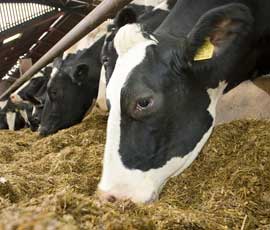What you need to know about MRSA

Following the discovery of a new strain of MRSA in dairy cows across England, Farmers Weekly answers some of the common questions about the superbug.
What is MRSA?
MRSA stands for meticillin-resistant Staphylococcus aureus. It is a common skin bacterium that is resistant to a range of antibiotics.
An MRSA infection means the bacteria have got into the body through a break in the skin and multiplied.
How do bacteria become resistant to antibiotics?
When bacteria are treated with an antibiotic, some of them can survive. The surviving bacteria can mutate and may develop a resistance to the antibiotic. They can then multiply, ready to infect someone new.
The number of antibiotic-resistant bacteria has increased in recent years due to:
• People not finishing the full course of antibiotics they have been prescribed, allowing some bacteria to survive, develop a resistance to the antibiotic and then multiply
• Antibiotics being overused, which has allowed bacteria to develop resistance to a wide range of antibiotics
Does MRSA affect everyone it infects?
About one in three people carries the Staphylococcus aureus in their nose or on the surface of their skin without developing an infection.
People can carry MRSA weeks or months. They are unaware they are carriers because the bacteria do not harm them or cause symptoms, unlike people who are infected with MRSA.
How does infection happen?
If SA bacteria get into the body through a break in the skin, they can cause infections such as boils, an abscess or impetigo. If they get into the bloodstream they can cause more serious infections, such as blood poisoning.
Who is most at risk?
MRSA will not normally infect a healthy person. MRSA has become associated with outbreaks in hospitals because people often have an entry for the bacteria (ie a wound), they tend to be older and weaker and they are surrounded by lots of people so the bacteria can spread.
How is it treated?
Bacterial infections are treated with antibiotics. However, MRSA bacteria are resistant to antibiotics that are normally used to treat SA infections.
Antibiotics can still be used to treat MRSA, but you may need a much higher dose over a much longer period, or treatment with an antibiotic to which the bacteria are not resistant (see MRSA infection – treatment).
What is the new strain of MRSA in cattle?
Scientists found the new strain while discovering a bacterium known to cause mastitis. Genetic tests on the bug discovered it had unconventional DNA which did not show up under traditional genetic tests.
Are consumers at risk?
No. The bacteria is killed when milk is pasteurised, meaning there is no risk of the bug finding its way into the food chain.
Are people working on dairy farms at risk?
Evidence suggests the MRSA bacteria are being exchanged between cattle and humans, probably by direct contact. Scientists are now investigating the potential risks to farm workers.
However a third of the population carries MRSA on their skin without becoming ill.
Is MRSA found in other farm animals?
A strain of the bacterium called MRSA ST398 has been found in some pig farms in Belgium, Italty, the Netherlands and Spain in recent years. It is also thought to have spread to poultry and cattle.
The strain has not been found in British livestock, but several cases of the infection have been discovered in humans in Scotland and England.
A second strain, MRSA STI, has been found in pigs in Italy, Spain and Cyprus. It is thought to pose a greater threat than ST398 as it passes more easily between humans.
